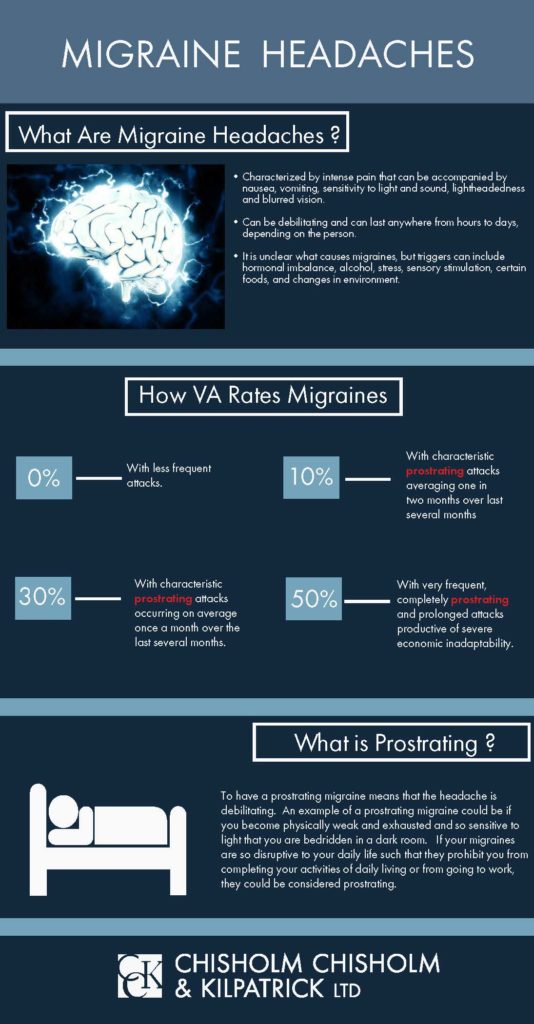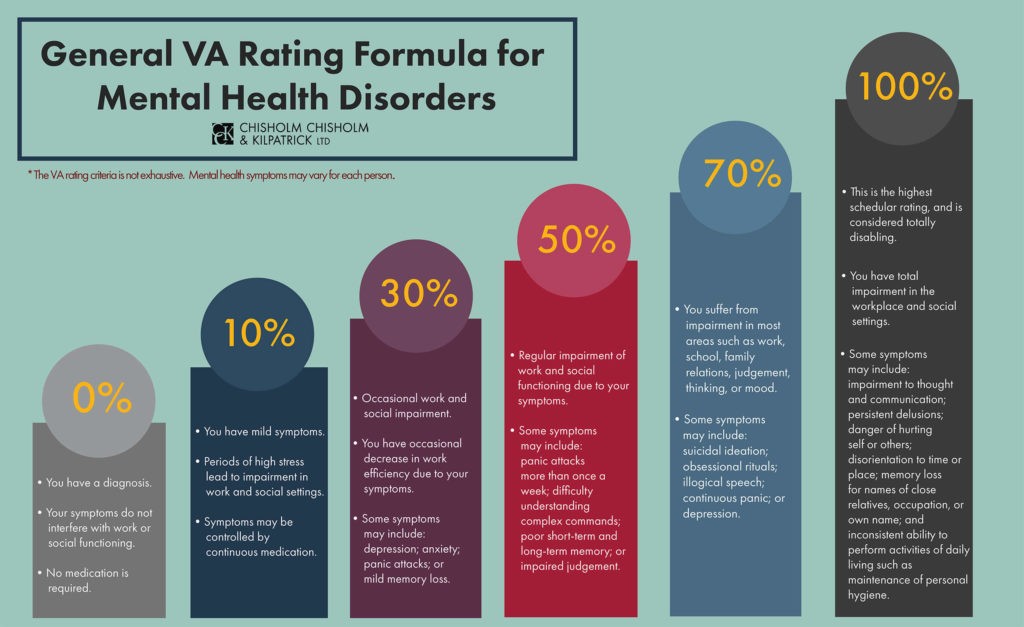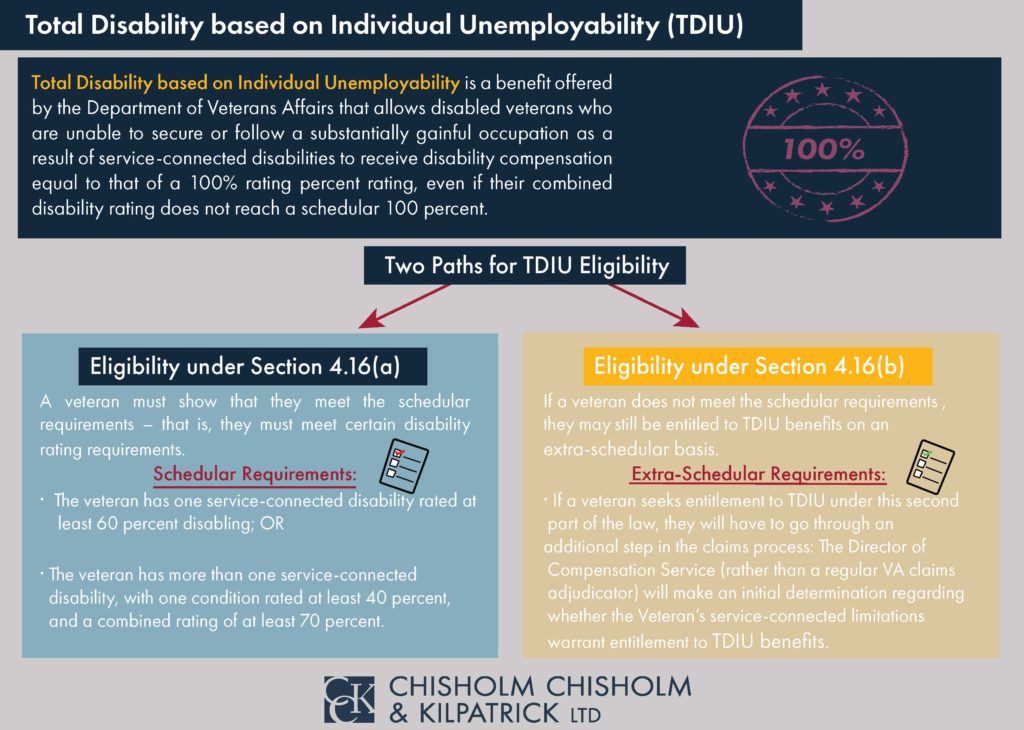VA Disability for Conditions Secondary to Migraines

CCK Law: Our Vital Role in Veterans Law
Migraines, a type of headache, can be a recurring, debilitating condition that affect the lives of many veterans. Migraines can also cause a variety of conditions and worsen other preexisting conditions. Veterans whose migraines cause or exacerbate other conditions may be entitled to VA disability benefits for their secondary condition.
What Are Migraines?
Migraines are a form of intense headache that can last for many hours. There is no singular, definitive cause of migraines; however, triggers may include hormonal imbalance, alcohol use, stress, sensory stimulation, certain foods, and changes in environment.
Symptoms of Migraines
- Pain
- Nausea
- Vomiting
- Sensitivity to light
- Lightheadedness
- Blurred vision
- Aura, or visual disturbances such as flashes of light
Medication may be used to treat migraines, as well as dietary changes, rest, and stress management. Doctors may also suggest that the person avoid triggering stimuli to help reduce migraines.
Migraines Among Veterans
Migraines are a very common condition among the veteran population. For instance, one 2024 study indicates that migraines may affect up to 36 percent of veterans of Operations Enduring Freedom/Iraqi Freedom (OEF/OIF), which is almost three times the rate of the general population.
Why Are Migraines So Common Among Veterans?
Due to the nature of service, veterans are often exposed to stimuli, or face situations, that typically cause migraines. Specifically, noise exposure, intense or stressful situations, and traumatic brain injury are all conditions which servicemembers may be exposed to more often than civilians. A traumatic brain injury (TBI) can be caused by a severe blow to the head or injury that penetrates the brain. Migraines are a common side effect of traumatic brain injury.
How Does VA Rate Migraines?
VA rates migraine headaches under 38 CFR § 4.124a, Schedule of Ratings – Neurological Conditions and Convulsive Disorders, Diagnostic Code 8100. This diagnostic code has ratings ranges from 0 to 50 percent, with criteria based on severity and frequency of the migraines. The rating assigned will correspond to the amount of VA disability compensation a veteran will receive. Below are the criteria for each rating:
- 50% – with very frequent completely prostrating and prolonged attacks productive of severe economic inadaptability
- 30% – with characteristic prostrating attacks occurring on an average of once a month over the last several months
- 10% – with characteristic prostrating attacks averaging one in two months over the last several months
- 0% – with less frequent attacks
The term “prostrating” generally means that the veteran’s migraine headaches are so severe and debilitating that they are required to lay down for an extended period of time due to complete exhaustion and physical weakness. Typically, prostrating migraines also require veterans to stop all activity and possibly take medication or seek medical attention.
What is Secondary Service Connection?
A secondary service-connected condition is one that resulted from a separate condition that is already service-connected. In claims for secondary service connection, proving a nexus is especially important. A nexus is a medical opinion that, in cases of secondary service connection, links a veteran’s secondary disability to their already service-connected disability.
For VA to grant secondary service connection, veterans must provide
- A diagnosis for the secondary condition; and
- Medical evidence showing the relationship between the service-connected condition and the secondary condition.
Importantly, secondary service connection functions the same as primary service connection in relation to VA disability benefits, meaning that ratings provide the same amount of compensation, regardless of whether the condition is connected on a primary or secondary basis.
Common Conditions Secondary to Migraines

Depression Secondary to Migraines
Depression is a serious mental health condition that affects the way a person thinks, feels, and acts. Common symptoms include persistent sadness, irritability, fatigue, and lack of motivation.
Like migraines, rates of depression are particularly high among veterans. Research has indicated that people who experience migraines are five times more likely to develop depression than those who do not experience migraines. Migraines are a chronic condition and can often cause a significant amount of recurring pain. Experiencing migraines routinely can cause a person to feel angry, sad, or defeated and may lead to depression.
Depression is rated under General Rating Formula for Mental Health Conditions at 0, 10, 30, 50, 70, and 100 percent.
Anxiety Secondary to Migraines
Anxiety is defined as intense, excessive, and persistent worry and fear about everyday situations. There are several types of anxiety disorders, such as generalized anxiety disorder, panic disorder, and various phobia-related disorders. It is estimated that one-third of adults in the U.S. suffer from anxiety disorders. Studies show that between 30 and 50 percent of people with chronic migraines have anxiety.
Anxiety can develop in response to migraines, such as when a person begins worrying about when their next migraine attack may occur. Anxiety, like depression, is rated as a mental health condition and ratings are issued based on the severity of the condition and the resulting level of social and occupational impairment.
Insomnia Secondary to Migraines
Insomnia is a sleep disorder marked by difficulty falling asleep or staying asleep, even when a person has the chance to do so. Insomnia can be acute or chronic.
Acute insomnia is typically the result of stress or a traumatic event. Chronic insomnia can be the result of stress, a traumatic event, life events, or habits that disrupt sleep, or may be associated with medical conditions or the use of certain medications. For example, the pain from chronic migraines could lead to difficulties sleeping, thereby causing insomnia.
People with insomnia may feel dissatisfied with their sleep and experience negative outcomes related to their energy level, mood, health, work performance, and quality of life.
Like anxiety and depression, VA will typically rate insomnia according to the Schedule of Ratings for Mental Disorders (38 CFR § 4.130) at 0, 10, 30, 50, 70, or 100 percent.

Sleep Apnea Secondary to Migraines
Sleep apnea, like insomnia, is a sleep disorder that can be connected to migraines. Sleep apnea is a serious condition in which a person’s breathing is repeatedly interrupted throughout the night.
There are three main types of sleep apnea:
- Obstructive Sleep Apnea—the most common form of sleep apnea; occurs when the throat muscles intermittently relax and block the airway during sleep
- Central Sleep Apnea—occurs when the brain does not send proper signals to the muscles that control breathing
- Complex (Mixed) Sleep Apnea—occurs when a person has both obstructive and central sleep apnea
In order to receive a VA disability compensation rating for sleep apnea, VA requires that a sleep study be conducted. Ratings for sleep apnea can be issued at 0, 30, 50, or 100 percent, depending on severity.
GERD Secondary to Migraines
Gastroesophageal Reflux Disease, or GERD, is a digestive disorder characterized by the occurrence of stomach acid flowing back up the esophagus from the stomach, causing discomfort and inflammation.
GERD is caused by frequent episodes of acid reflux. Symptoms can include heartburn, difficulty swallowing, regurgitation, and chest pain. Importantly, GERD can be caused by taking medications, such as NSAIDs, which are commonly used to treat migraines.
GERD is rated analogously to a hiatal hernia and can receive a rating of 10, 30, or 60 percent.

Vertigo Secondary to Migraines
Vertigo is a condition categorized by the sensation of feeling dizzy, lightheaded, or off-balance. People with mild vertigo may feel like the room is spinning, while in more severe cases, vertigo can result in nausea, vomiting, and nystagmus, or abnormal eye movements.
Symptoms of vertigo can last anywhere from a few minutes to a few hours. However, vertigo is almost always a symptom of another underlying condition, such as an inner ear condition or migraines.
Vertigo does not have a specific diagnostic code. It is usually rated under Diagnostic Code 6204 for peripheral vestibular disorders or Diagnostic Code 6205 for Meniere’s Disease/Syndrome.
Vertigo can be rated at 10 or 30 percent under Diagnostic Code 6204 or at 30, 60, or 100 percent under Diagnostic
TDIU for Migraines and Secondary Conditions
The frequency or severity of a person’s migraines, coupled with their migraine-related conditions may significantly impair their ability to work. Veterans who are prevented from gaining or maintaining substantially gainful employment may be entitled to a monthly VA disability benefit called total disability based on individual unemployability, or TDIU.
TDIU allows veterans to receive compensation at the 100 percent rate, even if their combined VA disability rating is less than that.
There are two forms of TDIU: schedular or extraschedular.
In order to be awarded schedular TDIU, veterans need to meet the criteria outlined under 38 CFR § 4.16a. The criteria requires that veterans must have one condition rated at 60 percent minimum OR two conditions that can be combined to reach 70 percent, where one condition is at a minimum of 40 percent. Importantly, the ratings for primary service-connected conditions and secondary service-connected conditions both contribute to a veteran’s combined rating.
Veterans who do not meet these qualifications may be eligible for extraschedular TDIU. In order to receive extraschedular TDIU, veterans must prove that their condition(s) uniquely hinder their ability to maintain substantially gainful employment. Extraschedular TDIU is rated under 38 CFR § 4.16b.
Getting Assistance with VA Benefits for Conditions Secondary to Migraines
Veterans who have filed a claim for secondary service connection may have received a denial from VA. If your claim for benefits for a condition secondary to migraines was denied, the experienced team at CCK may be able to help you.
If you are struggling in the appeal process with VA, call our office today at 800-544-9144 or contact us online for a free case evaluation.
About the Author
Share this Post



